
Bread is a very important food in my German culture. In fact, we eat bread with almost every meal in Germany. I count myself fortunate to live near a great bakery called Phlour, a family-owned business in Chicago's Edgewater neighborhood. I love their breads!
The most important ingredient for sourdough bread is the starter. At The Chopping Block, we have a sourdough starter named Ethel, and all she needs is to be fed once a week to stay healthy and strong. I decided to take some home (mine is called Hilde) to help me begin my bread baking journey.

Years ago, I came across a no-knead bread baking recipe in The New York Times from the Sullivan Bakery in Manhattan. I was pleasantly surprised to learn how simple it is to make it! All you need is four ingredients: flour, water, yeast and salt. Of course, you also need the right equipment, time and dedication. Allow me to share with you some of the tips I've learned while exploring bread baking during quarantine.
- Measuring using a kitchen scale is more precise, and you will save time not having to convert the measurements as most bread recipes are in grams.
- Never use hot water to feed your starter; it will kill it! Always make sure to use lukewarm water at about 90º F. Test the temperature by letting the water from the faucet run over your wrist. If the water is too cold, your starter would not be activated.
- Use parchment paper instead of a towel to cover the bowl, parchment would not stick to your dough and you could reuse the same parchment as a working surface and to lift the dough and slide it into the pot.
- Using a cast iron Dutch oven is also important. These wonderful vessels maintain the moisture and the heat.
I created my own version of this recipe which makes two loaves of bread. Chances are that you will bake one loaf at the time. So, I would recommend shaping the second loaf, storing in your refrigerator, and baking it the next day. Let it rise in a warm spot for about an hour and a half outside of the fridge prior to baking.
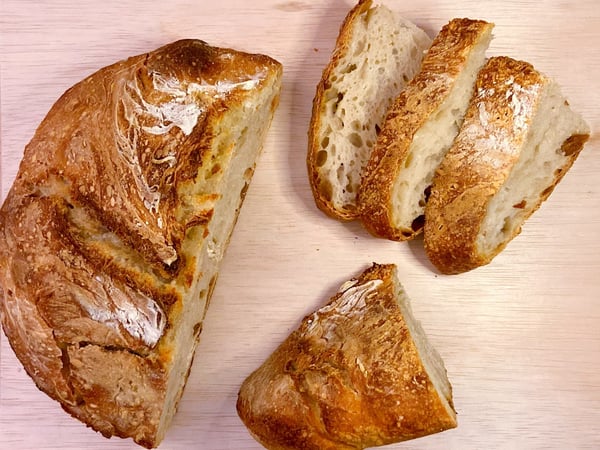
No-Knead Sourdough Bread
Scroll down for a printable version of this recipe
700 grams all-purpose flour
300 grams whole wheat flour or a combination of rye or spelt flour
20 grams fine sea salt, or fine kosher salt
750 gram lukewarm water (90 degrees)
1/2 cup sourdough starter
1. Using a spatula or wooden spoon, mix 100g of all purpose flour and 100g of lukewarm water (90ºF) in a small bowl. In a medium size bowl, place about half a cup of the sourdough starter. “Feed” your starter by adding the flour and water mixture you just made. Cover it up with Saran wrap, place a kitchen towel over it and leave it undisturbed on a warm spot on your kitchen counter.
2. Repeat the same process the next day. Try to feed the starter at the same time if possible, it should become nice and bubbly. Wait about two hours after the second feeding before continuing.
3. At this time, weigh out the flours and the water and mix everything together including the starter. Let the mixture rise for about 2 hours.
4. Dust some flour on a wooden board, take the mixture out of the bowl and fold in the edges creating a ball, but there is no need to knead it. Let it rest an additional 30 minutes covered up with parchment paper or a kitchen towel.
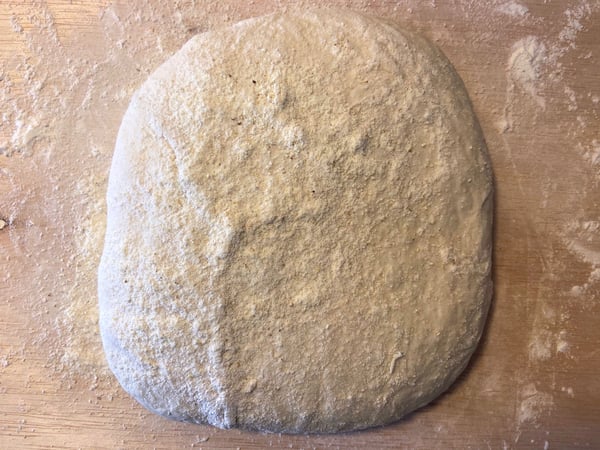
5. Preheat the oven to 450ºF. Place your covered cast iron Dutch oven inside. It's important that you heat the Dutch oven while the oven is preheating. Once your oven has reached the temperature, put your oven mittens on and carefully lift the pot out, remove the lid and place the dough sliding it from the towel or parchment paper, inside the pot upside down.
6. If your bread looks messy, don't worry about it. Put the lid back on and bake for about 30 minutes. Remove the lid after this time and bake for another 15 minutes to ensure the bread will have a nice crust. Your bread should be nice and golden brown and firm to the touch.
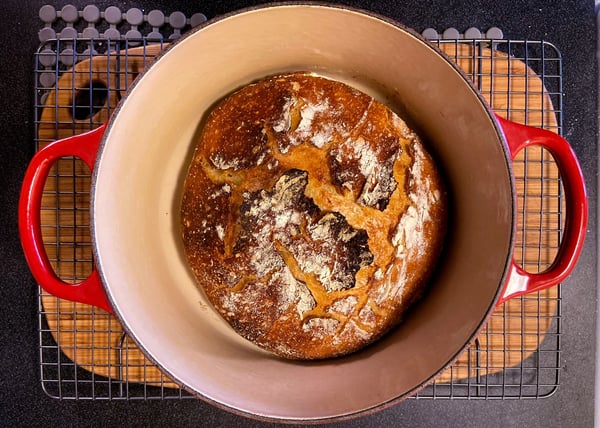
7. Using a large spatula, remove the bread carefully from the pot and transfer to a cooling wire rack. Wait until it’s completely cool before slicing into it.
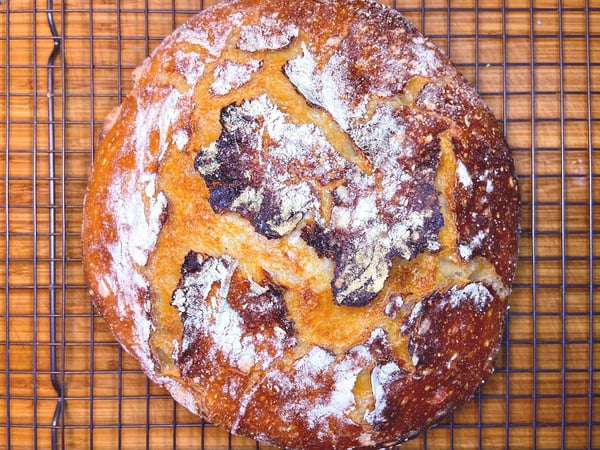
If you are not eating it in the next three days or so, it's okay to store the bread in the freezer. I prefer to slice the loaf and freeze the individual slices in zippered storage bags so you can just remove what you need from the freezer. Defrost in the fridge a day prior to consumption. I like to place my slices in the toaster for a nice crunchy bread served with jam in the morning.
We are offering virtual baking classes every Saturday morning. Join us for these upcoming classes and check out everything virtual we're offering on our class calendar:
- Strawberry Shortcakes Saturday, June 13 at 11am CST
- Lemon-Ricotta Cheesecake Saturday, June 20 at 11am CST
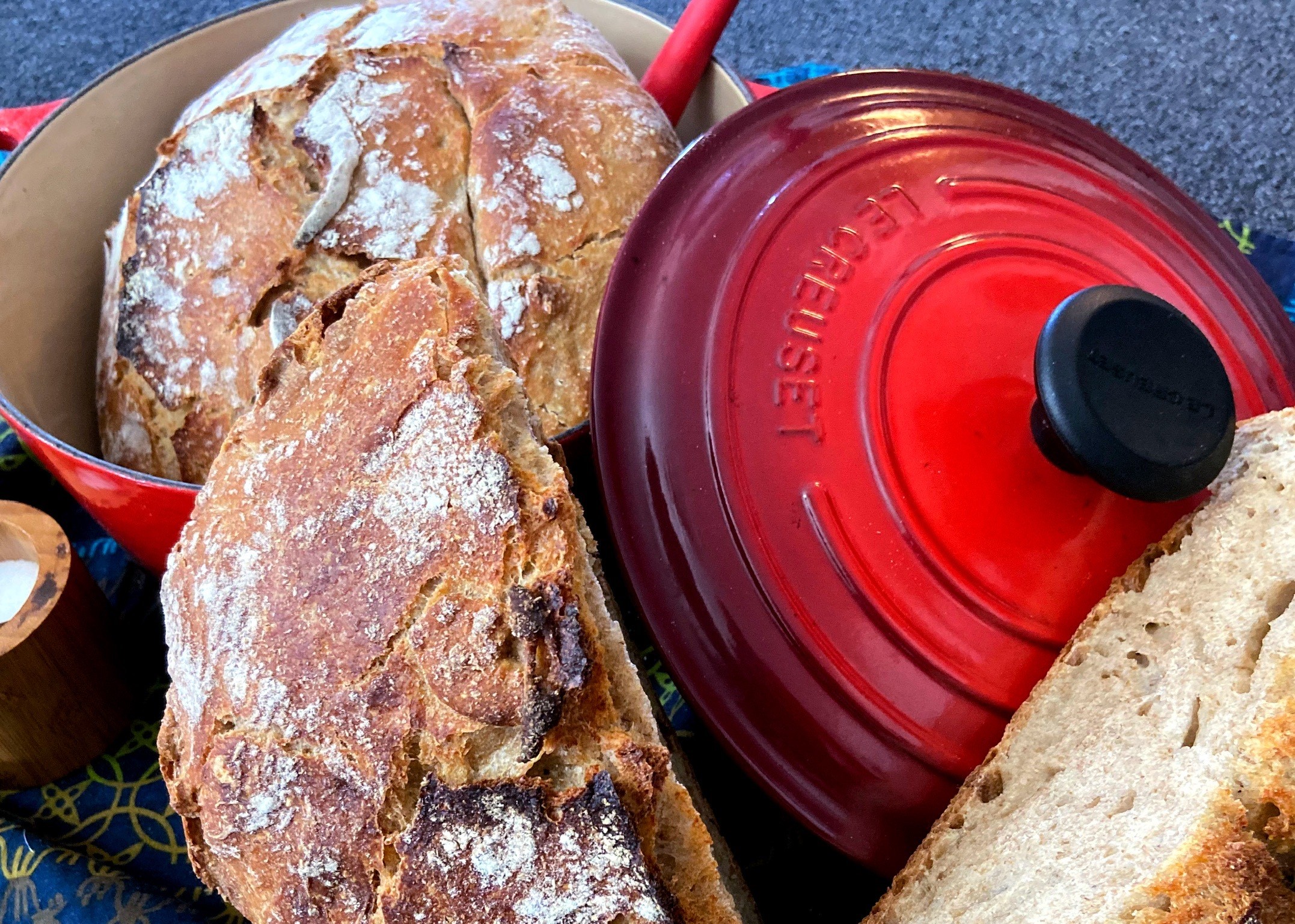
No-Knead Sourdough Bread
Ingredients:
- 700 grams all-purpose flour
- 300 grams whole wheat flour or a combination of rye or spelt flour
- 20 grams fine sea salt, or fine kosher salt
- 750 gram lukewarm water (90 degrees)
- 1/2 cup sourdough starter
Instructions:
- Using a spatula or wooden spoon, mix 100g of all purpose flour and 100g of lukewarm water (90ºF) in a small bowl. In a medium size bowl, place about half a cup of the sourdough starter. “Feed” your starter by adding the flour and water mixture you just made. Cover it up with Saran wrap, place a kitchen towel over it and leave it undisturbed on a warm spot on your kitchen counter.
- Repeat the same process the next day. Try to feed the starter at the same time if possible, it should become nice and bubbly. Wait about two hours after the second feeding before continuing.
- At this time, weigh out the flours and the water and mix everything together including the starter. Let the mixture rise for about 2 hours.
- Dust some flour on a wooden board, take the mixture out of the bowl and fold in the edges creating a ball, but there is no need to knead it. Let it rest an additional 30 minutes covered up with parchment paper or a kitchen towel.
- Preheat the oven to 450ºF. Place your covered cast iron Dutch oven inside. It's important that you heat the Dutch oven while the oven is preheating. Once your oven has reached the temperature, put your oven mittens on and carefully lift the pot out, remove the lid and place the dough sliding it from the towel or parchment paper, inside the pot upside down.
- If your bread looks messy, don't worry about it. Put the lid back on and bake for about 30 minutes. Remove the lid after this time and bake for another 15 minutes to ensure the bread will have a nice crust. Your bread should be nice and golden brown and firm to the touch.
- Using a large spatula, remove the bread carefully from the pot and transfer to a cooling wire rack. Wait until it’s completely cool before slicing into it.

